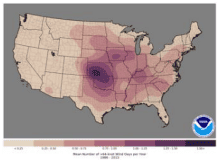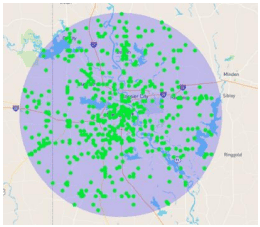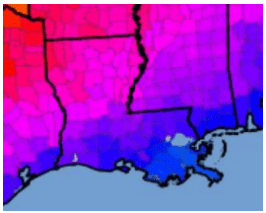Severe Thunderstorm Winds
Data Limitations
Population and temporal biases (i.e., a greater number of reports in recent decades), a limited number of weather stations that record wind speed, and the highly localized nature of severe thunderstorm winds, mean that data are not of sufficient quality to robustly determine whether there have been trends over a long period of time (e.g., 100+ years).
Definition and Description
High winds are defined as sustained non-convective wind speeds of 40 mph or greater lasting for 1 hour or longer, or gusts of 58 mph or greater for any duration.
Severe thunderstorm winds are winds of 58 mph or greater when convection (i.e., thunderstorm) is present.
High winds can occur with thunderstorms, but also with frontal passages and gradients between areas of high and low pressure. There are several types of wind events.
- Straight-line winds are thunderstorm winds that do not have rotation and are different from tornadic winds.
- Downdraft winds can also be damaging and are a small column of air that rapidly sinks toward the ground.
- Downbursts describe wind events that are caused by a strong downdraft within a thunderstorm.
- Microbursts are small concentrated downbursts that produce an outward burst of strong winds at or near the surface.
Wind speeds and the effects can be measured by the Beaufort Wind Scale (NWS 2024), which ranges from 0 (calm winds) to 12 (hurricane-force winds).
Historical Data
Severe T-Storm Wind Days Per Year
(1986-2015)NOAA/National Weather Service Storm Prediction CenterThis map shows you the average number of days per year in which severe thunderstorm wind reports were received in your area. The map gives you a sense of the approximate number of days each year that you can expect to see severe thunderstorm winds (57 mph or greater) in your area.
1. Select any of the three wind climatology maps to view a larger image: Greater Than 50-Knots & Less Than 64-Knots, Greater Than 64-Knots, or All Wind Greater Than 50-Knots. Note: 50 knots is equal to 57 mph; 64 knots is equal to 73 mph.
Severe T-Storm Wind Reports
Wind: (1955-present) Southern Regional Climate CenterThis interactive tool shows you the historical record for individual severe thunderstorm wind reports (gust of 57 mph or greater) in your area. It can be used to determine severe thunderstorm wind events that have impacted your area or nearby.
1. On the left side of the screen, click on Search within Radius. 2. Choose the diameter of the area of which you want to investigate (25 or 50 miles). 3. Pan, zoom, and then click on the map area of interest. 4. Select Wind (de-select other hazards). 5. Reports are displayed on the map and in two tables below the map. 6. Map: Mouse over individual storm reports for details. 7. Tables: There are two tables, Recent Storm Data and Historical Storm Data. Click on the column header to sort by column of interest. For example, to view the dates on which the highest wind occurred, click on the Scale column headers to sort by the highest wind value.
Severe T-Storm Watch Climatology Map
(2004-2023) NOAA/National Weather Service Storm Prediction CenterThis map shows a 20-year climatology of severe thunderstorm watches. From this map, you can get a sense of the approximate number of days each year you can expect to have a severe thunderstorm watch issued for your parish.
1. Under the Storm Prediction Center WCM Page banner near the top of the page, click on the Watch Frequency Maps link. 2. Scroll down a bit until you see 20y SPC Watch Climatology. 3. Click on the Average number of severe thunderstorm watches per year image to view it in larger form. Note: this WCM page contains a lot of other statistics about the hail, severe thunderstorm, and tornado products that come out of the NWS Storm Prediction Center if you are interested in digging deeper into the data.
Climate Change Trends
Damaging winds in Louisiana are associated with both tropical storms and thunderstorms. Louisiana has the second-highest frequency of thunderstorms per year, on average, in the contiguous U.S. (Frankson et al. 2022). More favorable environments for severe thunderstorms are expected, especially during the peak storm season (March-May), so associated increases in severe wind occurrences are projected. It is not known, however, whether the favorable environments will reach their potential of producing damaging winds (Kossin et al. 2017). Historically, severe thunderstorm winds have occurred more often in northern Louisiana.



